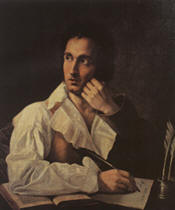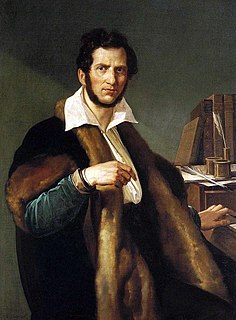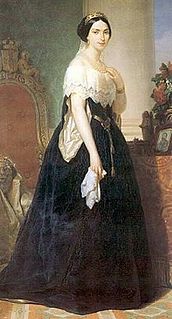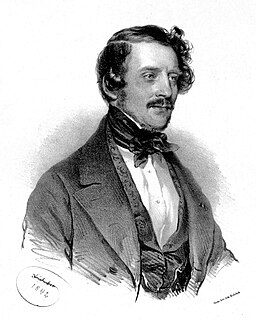Act 1
On the seashore of the island
Carrying a basket, Marcella emerges from her hut and observes the raging sea, expresses concern about "the raving one", and prepares to leave her basket of food under a bush for him: (Freme il mar lontan lontano / "The sea is agitated / I hear the thunder..."). Bartolomeo, her father, follows her. He roughly questions her motive and, while she offers the explanation that it is to observe the weather, he knows that she really has come to look for the "furious one". He discovers food hidden in the basket and, understanding that this is designed for the "madman", Cardenio, Bartolomeo describes the bizarre behavior of this man and despairs of the attraction which women seem to have in helping insane people: (So per chi. Sempre pietose / Fur la femmine con matti / "I know to whom. Women have always been pitiful to the insanes.") Marcella pleads with her father for help in order to protect him from himself.
Kaidamà, Bartolomeo's island native servant, joins the assembled islanders having been terrorized by Cardenio's madness, and he describes his experience of running away after being repeatedly hit. He continues to fear for his life, expressing his fear in an extensive aria that unless the people kill the madman, he will kill Kaidamà: (Aria: Scelsi la via brevissima / "I chose the shortest way / towards the farm"). However, Bartolomeo orders Kaidamà to go back to the farm, brandishing his whip as a threat.
Appearing to set off as instructed, Kaidamà hides in one of the huts as Cardenio is heard offstage. He enters and expresses his sadness when describing a woman who clearly was his love: (Aria: Raggio d'amor parea / Nel anno primo april degli anni / "Like a gleam of love she was / In the prime of her life / But she was as beautiful as she was evil / Mistress of deceit / She had roses on her face / And thorns hidden in her heart"). This sadness causes the onlookers some anguish, especially when they see Cardenio looking at the possibility of jumping from the clifftop and into the sea, but spotting Marcella, Cardenio moves away and into the rocks. The assembled company laments, Bartolomeo instructs his daughter to leave the basket of food, and then moves towards the rocks to find the madman.
As the storm grows in intensity, Marcella and Kaidamà leave the hut. They see a ship perilously making its way through the raging seas, and the assembled group watches as the ship breaks apart and sinks. Eleonora is thrown on the shore and Marcella and the farmers carry her to a rock. Terrified at the sight of Kaidamà, she recoils in horror: "Oh! extreme torment! I am still alive!": (Aria: Ah! lasciatemi, tiranni! / "Ah! leave me, cruel ones! / I feel too many sorrows altogether! / I want to die. / Pity is cruel / To a mournful heart"). As Marcella, Kaidamà, and the farmers interject words of comfort, Eleonora confesses that she deceived her husband, but that she still loves him—"I'm burning with a tardy love"—and that she is tormented by her guilt: "I deserve the cruelty of heavens" she exclaims. Marcella offers her a change of clothes, but when Bartolomeo returns, having failed to find Cardenio, he demands the identity of the woman.
Cardenio reaches the beach (Tutto è velen per me!....Per me sconvolto / È l'ordin di natura! ...Aprile istesso / "Everything is poison to me! To me the nature of Order is upset! April itself / Is productive only of thorns! The grass is bitter..") He asks himself why he was betrayed, expressing his continuing love for Eleonora. Kaidamà leaves his hut and is approached by the delusional Cardenio who offers love and a share of the food left for him. As they eat, Cardenio again recalls his love (Di quei occhi ilampi ardenti / Rispondeano agli occi miei / "The ardent flashes of her beautiful eyes / Answered my eyes"). Suddenly his anger is aroused. he violently grabs Kaidamà's hand and demands to know where Eleonora is. The servant is in pain and, in a duet finale, the two men sing of their frustrations: Cardenio (Era il sorriso giorni miei / "She was the joy of my life") while Kaidamà demands to be left alone and proclaims that he will run away. Barolomeo emerges from his hut, Cardenio leaves, and Kaidamà runs into the hut.
Off shore, a ship is seen. It comes to shore and Fernando and sailors disembark, the latter proclaiming their joy at a safe arrival and Ferrando telling that his mother had urged him to try to find his brother (Ah! dammi, o ciel pietoso /, Ch'io qua non giunga invano / "Ah, pitiful heaven / not to have not come here in vain"). As Fernando makes his way through the rocks, wondering who may be able to him locate Cardenio, Kaidamà emerges, and each is surprised by the other's strange appearance. However, Kaidamà is quickly convinced to provide help by Fernando's offer of money.
Interior of Bartolomeo's hut
Marcella, leading Eleonora, and the countrypeople enter. Eleonora confesses her lack of innocence, but she is told that her father is bringing the madman to them. Both arrive, Cardenio demanding to know where he is being taken and Bartolomeo proclaiming that he wants to hear the madman's story and share his sorrow. Wife his wife remaining out of sight, Cardenio describes his love for "a Portuguese virgin" and what happened (Le fibre m'arsero / Parea da me diviso / "I fell in love / I seemed to be beside myself". Both parents had approved, but the ship carrying her dowry sank, leaving her father ruined and her prospective father-in-law refusing to allow his son to marry her. They married anyway, but the young bridegroom had to go off to sea leaving his new bride with a relative who betrayed her, seduced her, and left him bereft. On his return, she insulted him and he sought solace by hiding on the island).
Standing out of sight in the crowd, Eleonora tries to break free to run to Cardenio, but she is held back by Marcella. Bartolomeo is sympathetic to Cardenio's plight, but his tears are rejected until Fernando makes himself known to his brother. The brothers embrace until, finally unable to control herself, Eleonora breaks free and collapses at her husband's feet. Although he is moved by her appearance, he quickly rejects her and all the help that he has received.
Each character expresses his/her feelings in a quartet finale: Eleonora's Nel mio squardo mezzo-spento / Mira espresso il pentimento / "Look how my lifeless eyes / Express my regret" is followed by Cardenio's Donna iniqua! E non remmenti / "Wicked woman! Don't you remember / Your deceptions, your oaths?", then Ferando's In quell volto, in quell'accento / "On that face, in those words / Can't you see her regret?" and finally by Kaidamà, Marcella and the country people with Ah! fuggir, scappar lo fate / "Ah! Let him run away". To this, the assembled groups respond "Ah! you make us tremble and freeze" as they watch Cardenio – followed by Fernando – flee from the scene. Eleonora collapses.
Act 2
On the seashore
The farmers and Kaidamà, searching for Cardenio, move along seashore and disappear. Cardenio then appears (Lasciatemi! Lasciatemi!... Tiranni! / "Leave me! Leave me!..Cruel ones!"). Eleonora hears him from inside the hut: "I want to see him again" she exclaims. Recognising her voice, he begins to run away, then falls. Eleonora and Marcella rush from the hut, Eleonora exclaiming: La mia vittima e qui. Cardenio! Oh in quale / Stato feral di morte / "My victim is here! Cardenio! Oh! In what / Funereal state"). Although he gets to his feet, he appears to be unable to see anything and is unaware of Eleonora’s presence. When in desperation he asks who will help him, Eleonora steps forward, telling him that only death can divide them from now on. Cardenio laments his state (La sventura / Fin la luce m’involo! / "Misfortune / Stole even the light from me") but, as he begins to be able to see again, he addresses her fondly. Suddenly the reality of who she is strikes him, and he grabs a cudgel and is about to strike her when Ferrando rushes in to prevents him. The madman quickly rushes off, leaping into the sea in order to drown himself. Tearing off his clothes, his brother plunges in after him.
Bartolomeo and the islanders come from along the shore, still searching for Cardenio. (Bartolomeo: Dove? Dove sara? Tutto la selva / Ho invan percorsa / "Where? Where is he? In vain / I scoured the whole wood"). Kaidamà rushes in and explains how Cardenio had plunged into the sea but had been rescued by Ferrando. Then another group of islanders appears, explaining that the madman seems now to be sane. This is immediately confirmed by Ferrando who recounts his brother’s wish to return to his country (Aria: No, quel di pria piu non e / "No, he is no longer his former self", and he expresses the hope that "his heart will make him shed a / A pitiful tear from his eye. / If pity wins, love triumphs..”)
As evening approaches, Cardenio, now dressed in new clothes and clean shaven, is melancholy (Aria: Qui pianse al pianto mio Qui la rividi / Piu bella del dolor…Pieta mi vines... / "Here she cried at my tears. Here I saw her again / More beautiful in her sorrow...Pity overcame me"). Unaware that Cardenio is watching, Kaidamà enters carrying two pistols. He is suddenly confronted by Cardenio who explains that his madness is over and demands that the pistols be handed over, telling the native that he has decided that dying together with Eleonora is the only way that he can continue (Aria: He deciso, e seco spento / Dileguar vedro gli affanni / "Yes, I decided: dying together with her, / I shall see my troubles disappear").
Darkness is descending as Ferrando brings Eleonora to Cardenio and, when she tearfully confesses, he gives her one of the pistols and orders her to shoot him, just as he will shoot her with the other one. It is only when the islanders enter bearing torches that Cardenio is able to see that Eleonora's pistol is pointed not at him but at herself. He realises that she does love him, and the couple is reunited: (Finale, Eleonora and Islanders. Eleonora's cavatina: Se pietoso di un oblio / Copri, o caro, I falli mieri / "My dear, if you forgive / My faults mercifully / I am fully happy / You are fully happy". Cabaletta: Che dalla gioia / "For the extreme happiness / I fear that my heart, / Oppressed by such joy, / Bursts in my breast"). [21]















